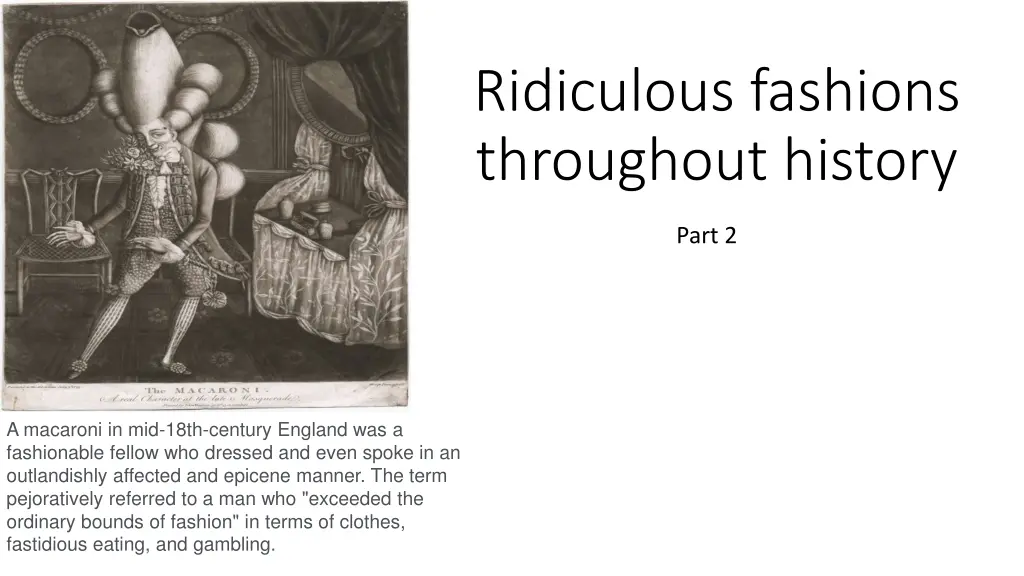
Outlandish Fashions Through History: Part 2
Explore ridiculous fashion trends in history, from mid-18th-century England's macaronis to Chinese lotus shoes and dangerous crinolines of the 19th century. Discover the bizarre and sometimes dangerous styles that have shaped the fashion world.
Download Presentation

Please find below an Image/Link to download the presentation.
The content on the website is provided AS IS for your information and personal use only. It may not be sold, licensed, or shared on other websites without obtaining consent from the author. If you encounter any issues during the download, it is possible that the publisher has removed the file from their server.
You are allowed to download the files provided on this website for personal or commercial use, subject to the condition that they are used lawfully. All files are the property of their respective owners.
The content on the website is provided AS IS for your information and personal use only. It may not be sold, licensed, or shared on other websites without obtaining consent from the author.
E N D
Presentation Transcript
Ridiculous fashions throughout history Part 2 A macaroni in mid-18th-century England was a fashionable fellow who dressed and even spoke in an outlandishly affected and epicene manner. The term pejoratively referred to a man who "exceeded the ordinary bounds of fashion" in terms of clothes, fastidious eating, and gambling.
Macaroni Remember Yankee Doodle Dandy, and how he stuck a feather in his cap and called it macaroni? That lyric is in reference to young French men in the 1750s, who took Italian fashion to the extreme. The most notable element of macaroni fashion was a huge wig with the tiny hat (or feather) on top, but it also included flashy waistcoats, bright stockings, and fancy buckled shoes. According to The New York Times, macaroni men also made up their own language (a combination of French, English, and Italian), making their dandy club of frippery and fashion even more exclusive.
Lotus shoes Lotus shoes were worn by Chinese girls with bound feet. For centuries, families repeatedly broke and folded the feet of their young daughters to create the tiny feet that epitomized femininity. The foot was bound with long ribbons to prevent growth. If the toes withered and fell off, even better. The process usually took between two to three years, and the girl s feet were bound for the rest of her life. Women with bound feet wore Lotus shoes, cone or sheath-shaped footwear that resembled a lotus bud. The shoes were made of silk or cotton and were usually ornate, embroidered with flowers, animals, and other traditional patterns. There were many attempts to ban foot binding throughout history. It was officially outlawed in 1912, though the practice was still carried out in secret in some areas of China for years after.
Crinolines The crinoline was a hoop skirt worn under the frocks of the 19th century, and it was made from horsehair, wood, or sometimes even steel. Intended to push the skirt out and give the wearer the appearance of big, regal hips, the crinoline was also incredibly dangerous. According to the FIDM Museum And Galleries, there are tales of women getting caught up in gusts of wind, being tossed off of cliffs, and getting caught in carriage wheel spooks yikes. There are also stories of women not being able to escape from burning buildings due to the width and stiffness of their skirts. In 1863 in Santiago, Chile, thousands of people died in a church fire caused by a gas lamp. Many of the victims were women, as their large crinoline skirts got caught in the door.






















